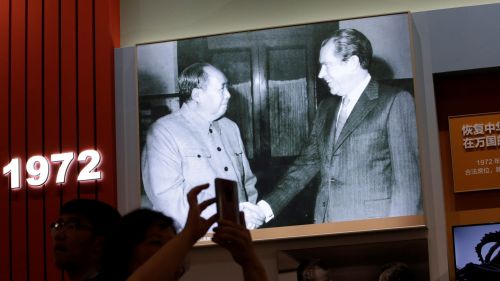What Nixon's 1972 China Trip Says About US-China Relations Today

Fifty years ago, US President Richard Nixon traveled to China and established the basis for a normalization of relations between the two powers. Are we due for another transformation?
Russia’s war against Ukraine has largely overshadowed the 50th anniversary of Nixon’s landmark trip to China in 1972, which established the basis for a normalization of relations between the two powers. Some commentators are now reflecting on the decisions made by Nixon in 1972 and whether the decision to embrace China was a sound strategic move. Today, as then, international politics seem to hinge on the triad of Washington, Moscow, and Beijing. Could the US today replicate Nixon’s feat, pulling China away from Russia?
Nixon Goes to China
Nixon’s 1972 trip to China may be the most famous overseas trip of any US president, as the visit quickly and firmly lodged itself into American cultural consciousness. In the foreign policy work, the trip become a touchstone for punditry, rivaled only by ‘Munich 1938’ and references to the Peloponnesian War. Today, modern commentators ache to re-enact the shift in great power relations between the United States, the USSR, and the PRC (with themselves, one imagines, playing the role of Kissinger). Outside the policy world, the notion that ‘only Nixon could go to China’ caught on (and was quoted in the 1991 film Star Trek VI: The Undiscovered Country as an ‘old Vulcan proverb’). Nixon’s China visit even inspired an opera.
In that process, the circumstances of the trip have become mythologized. Far from a bold stand against a hostile American public, polling from before and after Nixon’s trip shows that while there may be recriminations over US policy towards China in the past 50 years, Americans at the time were supportive of a change in policy.
Americans Open the Door to China, Nixon Walks Through
Nixon’s announcement that he planned to visit the PRC was front-page news. And nearly everyone heard about it: 85 percent in a July 1971 poll by the Opinion Research Corporation, and two-thirds (66%) thought it was a good thing. Indeed, as a Harris poll in August 1971 found, a majority of Americans (59%) wanted to recognize Communist China. But the desire among Americans to open to the PRC did not mean they wanted to throw Taiwan overboard. Instead, Americans were divided: 26 percent said the priority should be establishing relations with the PRC, while 25 percent wanted to focus on maintaining relations with the Nationalists—and three in ten (29%) said both were equally important. Still, the general idea of opening up to the PRC was a popular idea. A May 1971 Harris poll found that seven in ten Americans (70%) wanted to see friendlier relations between the United States and Communist China.
Americans also had policy preferences they wanted to see reflected in a renewed US-China relationship. Those included an agreement on control of nuclear weapons (76%), more talks between US and Chinese diplomats (74%), more cultural (71%) and sports (68%) exchanges, and travel by US and Chinese citizens to one another’s countries (52%). A plurality (47%) also said they’d like to see increased trade in non-strategic goods. However, as a Harris poll conducted in February 1972 just days before Nixon landed in Beijing showed, they didn’t expect all of these priorities to be satisfied. Only two in ten (22%) thought that the US and China would agree to control nuclear weapons; a majority (51%) thought it wouldn’t happen. Six in ten (62%) didn’t think it would bring about a faster end to the war in Vietnam.
Reviews of the trip were positive. In a March 1972 Gallup poll, nearly everyone – 97 percent of Americans – said they had heard or read about Nixon’s trip to China, and a Harris poll that August found that seventy percent of Americans rated the trip positively. Two-thirds (66%) thought it would be fairly or very effective in terms of improving world peace. Rather than changing public attitudes, the Nixon trip walked through a door already opened by the American public.
Today, American Views of China Have Plummeted
That’s not the case today. Rather than being open to rapprochement with Beijing, American views of China are at a real low point, as Chicago Council Surveys in 2021 clearly demonstrate. On a 0-100 feeling thermometer scale, where 0 represents a very cold, unfavorable feeling and 100 represents a very warm, favorable feeling, Americans rate China a chilly 33—up a single point from the 2020 low of 32. There are also notable partisan differences: Republicans give China an average rating of 23, a record low in Council polling dating back to 1978, while Democrats rate China an average of 39, up slightly from the summer of 2020 though lower than in all other prior Council surveys. Independents split the difference at 34, close to their all-time low of 33 in 2020.
It is difficult to overstate the significance of this decline in American views of China. Despite the many challenges in Sino-American relations in the four decades between 1978 and 2018, American feelings toward China remained fairly consistent, usually in the mid-40s. Since 2018, however, opinion has plummeted. The present overall average of 33 puts American views of China as low as views of the Soviet Union during the Cold War. The comparison is particularly apt for Republicans: the low point for the Soviet Union among Republicans came in 1982 at 22.
The decline in American esteem for China today has also lasted far longer than any prior downturn. Days after the military crackdown on student protesters in Tiananmen Square in 1989, a Los Angeles Times poll showed that 78 percent of Americans held an unfavorable view of China. But by August, a Gallup poll found that number had shifted to 58 percent—a rapid improvement in perception. By contrast, negative views of China have been steadily on the rise since 2018. And though they are no longer falling in Council polling, neither has China’s public image seen the kind of swift recovery it saw in 1989.
And it’s not just the public that has a negative view of China – policymakers are increasingly focused on China as a competitor. As Eliot Chen points out in The Wire, hundreds of China-related bills have been introduced into Congress in recent years, either as serious policy efforts to restrict some element of US-China interaction or as a way for politicians to establish their China-hawk bona fides. Even among Democrats, who are somewhat less negative towards China than Republicans, their debate in the 2020 presidential primary centered on how tough on China each candidate would be, rather than any sense of looking for a more cooperative relationship with Beijing.
Negative Views of China Preclude a Second Coming of Nixon
Combining a more hostile public with a more hostile Congress makes the comparisons to the early 1970s a hard sell. Contrary to what Nixon faced at the time, the domestic political circumstances in the United States today hardly lend themselves to a renewed embrace of Beijing. Nor was Nixon’s trip simply a bold stroke of a visionary presidential administration that led other political actors to fall in line. Instead, Nixon’s trip built on prior signals that China was interesting in changing the state of relations, favorable international geopolitics, and a supportive American public. Without that foundation, there won’t be a repeat of the 1972 pivot.

